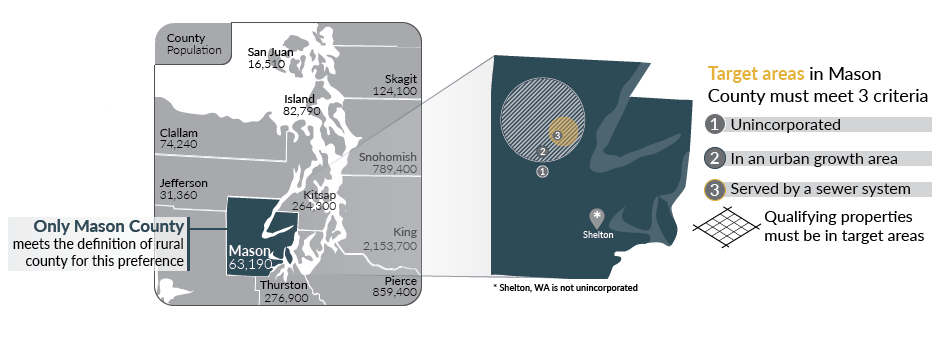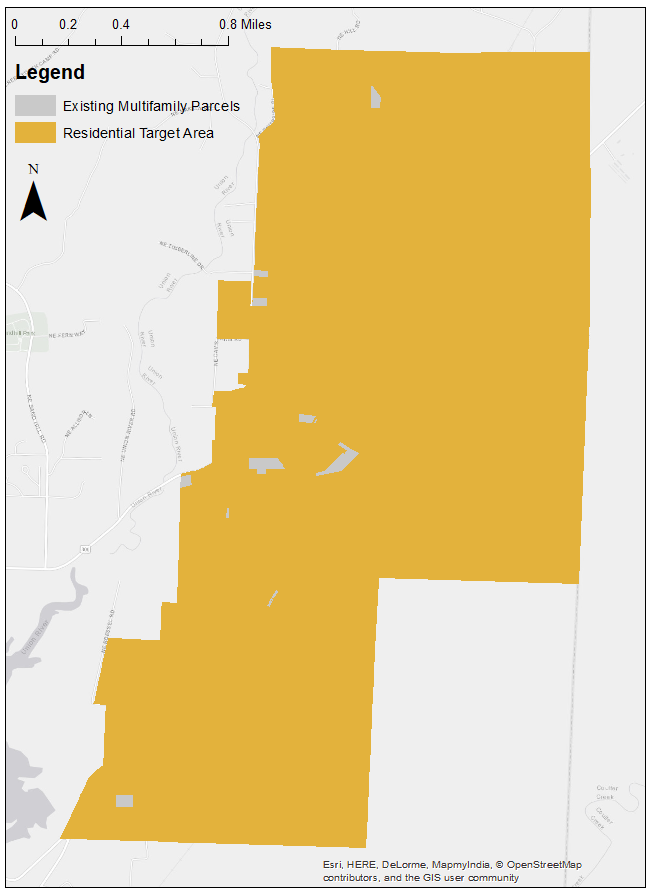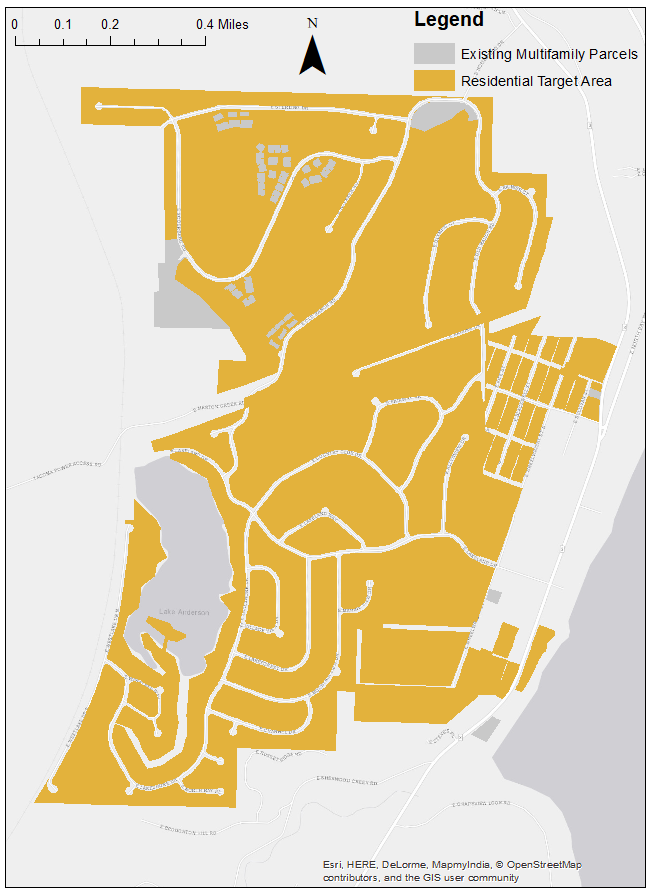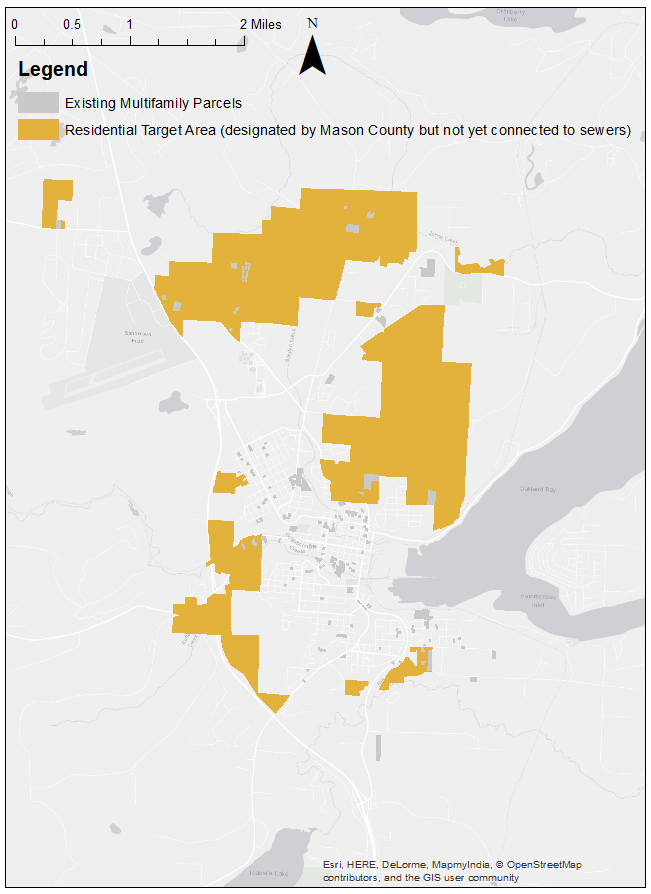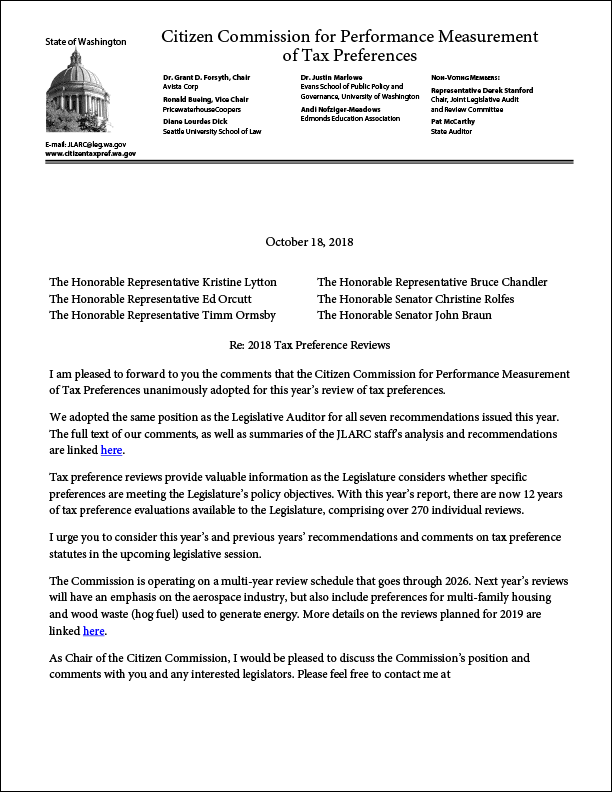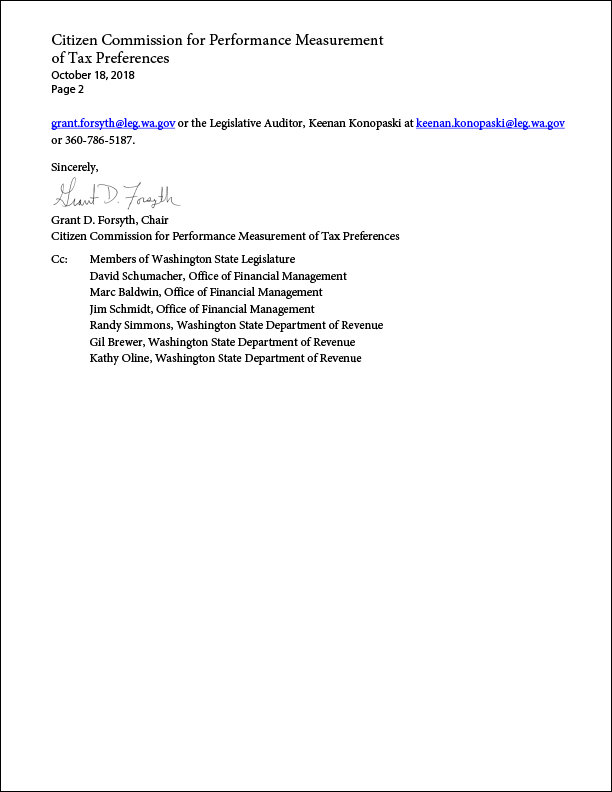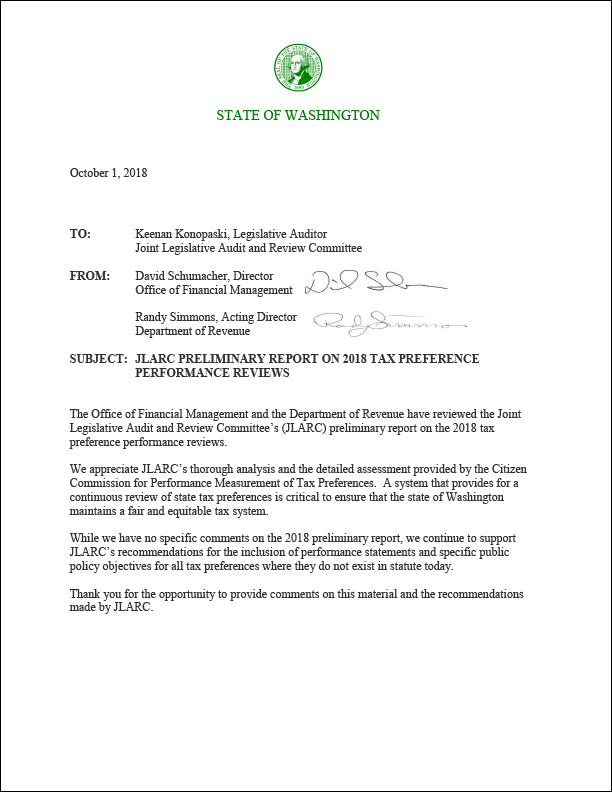Chapter 84.14 RCW
New and rehabilitated multiple-unit dwellings in urban centers
Tax preference performance statement—2014 c 96:
This section is the tax preference performance statement for the tax preference
contained in RCW 84.14.040 and 84.14.060. This performance statement is only intended to
be used for subsequent evaluation of the tax preference. It is not intended to create a
private right of action by any party or be used to determine eligibility for
preferential tax treatment.
(1) The legislature categorizes this tax preference as one intended to induce certain
designated behavior by taxpayers, as indicated in RCW 82.32.808(2)(a).
(2) It is the legislature's specific public policy objective to stimulate the
construction of new multifamily housing in urban growth areas located in unincorporated
areas of rural counties where housing options, including affordable housing options, are
severely limited. It is the legislature's intent to provide the value of new housing
construction, conversion, and rehabilitation improvements qualifying under chapter 84.14
RCW an exemption from ad valorem property taxation for eight to twelve years, as
provided for in RCW 84.14.020, in order to provide incentives to developers to construct
new multifamily housing thereby increasing the number of affordable housing units for
low to moderate-income residents in certain rural counties.
(3) If a review finds that at least twenty percent of the new housing is developed and
occupied by households making at or below eighty percent of the area median income, at
the time of occupancy, adjusted for family size for the county where the project is
located or where the housing is intended exclusively for owner occupancy, the household
may earn up to one hundred fifteen percent of the area median income, at the time of
sale, adjusted for family size for the county where the project is located, then the
legislature intends to extend the expiration date of the tax preference.
(4) In order to obtain the data necessary to perform the review in subsection (3) of
this section, the joint legislative audit and review committee may refer to data
provided by counties in which beneficiaries are utilizing the preference, the office of
financial management, the department of commerce, the United States department of
housing and urban development, and other data sources as needed by the joint legislative
audit and review committee." [ 2014 c 96 § 1.]
RCW 84.14.005
Findings
The legislature finds:
(1) That in many of Washington's urban centers there is insufficient availability of
desirable and convenient residential units, including affordable housing units, to meet
the needs of a growing number of the public who would live in these urban centers if
these desirable, convenient, attractive, affordable, and livable places to live were
available;
(2) That the development of additional and desirable residential units, including
affordable housing units, in these urban centers that will attract and maintain a
significant increase in the number of permanent residents in these areas will help to
alleviate the detrimental conditions and social liability that tend to exist in the
absence of a viable mixed income residential population and will help to achieve the
planning goals mandated by the growth management act under RCW 36.70A.020; and
(3) That planning solutions to solve the problems of urban sprawl often lack incentive
and implementation techniques needed to encourage residential redevelopment in those
urban centers lacking a sufficient variety of residential opportunities, and it is in
the public interest and will benefit, provide, and promote the public health, safety,
and welfare to stimulate new or enhanced residential opportunities, including affordable
housing opportunities, within urban centers through a tax incentive as provided by this
chapter.
[ 2007 c 430 § 1; 1995 c 375 § 1.]
RCW 84.14.007:
Purpose
It is the purpose of this chapter to encourage increased residential opportunities,
including affordable housing opportunities, in cities that are required to plan or
choose to plan under the growth management act within urban centers where the governing
authority of the affected city has found there is insufficient housing opportunities,
including affordable housing opportunities. It is further the purpose of this chapter to
stimulate the construction of new multifamily housing and the rehabilitation of existing
vacant and underutilized buildings for multifamily housing in urban centers having
insufficient housing opportunities that will increase and improve residential
opportunities, including affordable housing opportunities, within these urban centers.
To achieve these purposes, this chapter provides for special valuations in residentially
deficient urban centers for eligible improvements associated with multiunit housing,
which includes affordable housing. It is an additional purpose of this chapter to allow
unincorporated areas of rural counties that are within urban growth areas to stimulate
housing opportunities and for certain counties to stimulate housing opportunities near
college campuses to promote dense, transit-oriented, walkable college communities.
[ 2014 c 96 § 2; 2012 c 194 § 1; 2007 c 430 § 2; 1995 c 375 § 2.]
RCW 84.14.010
Definitions
The definitions in this section apply throughout this chapter unless the context
clearly requires otherwise.
(1) "Affordable housing" means residential housing that is rented by a person or
household whose monthly housing costs, including utilities other than telephone, do not
exceed thirty percent of the household's monthly income. For the purposes of housing
intended for owner occupancy, "affordable housing" means residential housing that is
within the means of low or moderate-income households.
(2) "Campus facilities master plan" means the area that is defined by the University of
Washington as necessary for the future growth and development of its campus facilities
for campuses authorized under RCW 28B.45.020.
(3) "City" means either (a) a city or town with a population of at least fifteen
thousand, (b) the largest city or town, if there is no city or town with a population of
at least fifteen thousand, located in a county planning under the growth management act,
or (c) a city or town with a population of at least five thousand located in a county
subject to the provisions of RCW 36.70A.215.
(4) "County" means a county with an unincorporated population of at least three hundred
fifty thousand.
(5) "Governing authority" means the local legislative authority of a city or a county
having jurisdiction over the property for which an exemption may be applied for under
this chapter.
(6) "Growth management act" means chapter 36.70A RCW.
(7) "High cost area" means a county where the third quarter median house price for the
previous year as reported by the Washington center for real estate research at
Washington State University is equal to or greater than one hundred thirty percent of
the statewide median house price published during the same time period.
(8) "Household" means a single person, family, or unrelated persons living
together.
(9) "Low-income household" means a single person, family, or unrelated persons living
together whose adjusted income is at or below eighty percent of the median family income
adjusted for family size, for the county where the project is located, as reported by
the United States department of housing and urban development. For cities located in
high-cost areas, "low-income household" means a household that has an income at or below
one hundred percent of the median family income adjusted for family size, for the county
where the project is located.
(10) "Moderate-income household" means a single person, family, or unrelated persons
living together whose adjusted income is more than eighty percent but is at or below one
hundred fifteen percent of the median family income adjusted for family size, for the
county where the project is located, as reported by the United States department of
housing and urban development. For cities located in high-cost areas, "moderate-income
household" means a household that has an income that is more than one hundred percent,
but at or below one hundred fifty percent, of the median family income adjusted for
family size, for the county where the project is located.
(11) "Multiple-unit housing" means a building having four or more dwelling units not
designed or used as transient accommodations and not including hotels and motels.
Multifamily units may result from new construction or rehabilitated or conversion of
vacant, underutilized, or substandard buildings to multifamily housing.
(12) "Owner" means the property owner of record.
(13) "Permanent residential occupancy" means multiunit housing that provides either
rental or owner occupancy on a nontransient basis. This includes owner-occupied or
rental accommodation that is leased for a period of at least one month. This excludes
hotels and motels that predominately offer rental accommodation on a daily or weekly
basis.
(14) "Rehabilitation improvements" means modifications to existing structures, that are
vacant for twelve months or longer, that are made to achieve a condition of substantial
compliance with existing building codes or modification to existing occupied structures
which increase the number of multifamily housing units.
(15) "Residential targeted area" means an area within an urban center or urban growth
area that has been designated by the governing authority as a residential targeted area
in accordance with this chapter. With respect to designations after July 1, 2007,
"residential targeted area" may not include a campus facilities master plan.
(16) "Rural county" means a county with a population between fifty thousand and
seventy-one thousand and bordering Puget Sound.
(17) "Substantial compliance" means compliance with local building or housing code
requirements that are typically required for rehabilitation as opposed to new
construction.
(18) "Urban center" means a compact identifiable district where urban residents may
obtain a variety of products and services. An urban center must contain:
(a) Several existing or previous, or both, business establishments that may include but
are not limited to shops, offices, banks, restaurants, governmental agencies;
(b) Adequate public facilities including streets, sidewalks, lighting, transit,
domestic water, and sanitary sewer systems; and
(c) A mixture of uses and activities that may include housing, recreation, and cultural
activities in association with either commercial or office, or both, use.
[ 2017 c 52 § 16; 2014 c 96 § 3. Prior: 2012 c 194 § 2; prior: 2007 c 430 § 3; 2007 c
185 § 1; 2002 c 146 § 1; 2000 c 242 § 1; 1997 c 429 § 40; 1995 c 375 § 3.]
NOTES:
Effective date—2007 c 185: "This act is necessary for the immediate preservation of the
public peace, health, or safety, or support of the state government and its existing
public institutions, and takes effect July 1, 2007." [ 2007 c 185 § 3.]
Severability—1997 c 429: See note following RCW 36.70A.3201.
RCW 84.14.020
Exemption—Duration—Valuation
(1)(a) The value of new housing construction, conversion, and rehabilitation
improvements qualifying under this chapter is exempt from ad valorem property taxation,
as follows:
(i) For properties for which applications for certificates of tax exemption eligibility
are submitted under chapter 84.14 RCW before July 22, 2007, the value is exempt for ten
successive years beginning January 1 of the year immediately following the calendar year
of issuance of the certificate; and
(ii) For properties for which applications for certificates of tax exemption
eligibility are submitted under chapter 84.14 RCW on or after July 22, 2007, the value
is exempt:
(A) For eight successive years beginning January 1st of the year immediately following
the calendar year of issuance of the certificate; or
(B) For twelve successive years beginning January 1st of the year immediately following
the calendar year of issuance of the certificate, if the property otherwise qualifies
for the exemption under chapter 84.14 RCW and meets the conditions in this subsection
(1)(a)(ii)(B). For the property to qualify for the twelve-year exemption under this
subsection, the applicant must commit to renting or selling at least twenty percent of
the multifamily housing units as affordable housing units to low and moderate-income
households, and the property must satisfy that commitment and any additional
affordability and income eligibility conditions adopted by the local government under
this chapter. In the case of projects intended exclusively for owner occupancy, the
minimum requirement of this subsection (1)(a)(ii)(B) may be satisfied solely through
housing affordable to moderate-income households.
(b) The exemptions provided in (a)(i) and (ii) of this subsection do not include the
value of land or nonhousing-related improvements not qualifying under this chapter.
(2) When a local government adopts guidelines pursuant to RCW 84.14.030(2) and includes
conditions that must be satisfied with respect to individual dwelling units, rather than
with respect to the multiple-unit housing as a whole or some minimum portion thereof,
the exemption may, at the local government's discretion, be limited to the value of the
qualifying improvements allocable to those dwelling units that meet the local
guidelines.
(3) In the case of rehabilitation of existing buildings, the exemption does not include
the value of improvements constructed prior to the submission of the application
required under this chapter. The incentive provided by this chapter is in addition to
any other incentives, tax credits, grants, or other incentives provided by law.
(4) This chapter does not apply to increases in assessed valuation made by the assessor
on nonqualifying portions of building and value of land nor to increases made by lawful
order of a county board of equalization, the department of revenue, or a county, to a
class of property throughout the county or specific area of the county to achieve the
uniformity of assessment or appraisal required by law.
(5) At the conclusion of the exemption period, the new or rehabilitated housing cost
shall be considered as new construction for the purposes of chapter 84.55 RCW.
[ 2007 c 430 § 4; 2002 c 146 § 2; 1999 c 132 § 1; 1995 c 375 § 5.]
RCW 84.14.030
Application—Requirements.
An owner of property making application under this chapter must meet the following
requirements:
(1) The new or rehabilitated multiple-unit housing must be located in a residential
targeted area as designated by the city or county;
(2) The multiple-unit housing must meet guidelines as adopted by the governing
authority that may include height, density, public benefit features, number and size of
proposed development, parking, income limits for occupancy, limits on rents or sale
prices, and other adopted requirements indicated necessary by the city or county. The
required amenities should be relative to the size of the project and tax benefit to be
obtained;
(3) The new, converted, or rehabilitated multiple-unit housing must provide for a
minimum of fifty percent of the space for permanent residential occupancy. In the case
of existing occupied multifamily development, the multifamily housing must also provide
for a minimum of four additional multifamily units. Existing multifamily vacant housing
that has been vacant for twelve months or more does not have to provide additional
multifamily units;
(4) New construction multifamily housing and rehabilitation improvements must be
completed within three years from the date of approval of the application;
(5) Property proposed to be rehabilitated must fail to comply with one or more
standards of the applicable state or local building or housing codes on or after July
23, 1995. If the property proposed to be rehabilitated is not vacant, an applicant must
provide each existing tenant housing of comparable size, quality, and price and a
reasonable opportunity to relocate; and
(6) The applicant must enter into a contract with the city or county approved by the
governing authority, or an administrative official or commission authorized by the
governing authority, under which the applicant has agreed to the implementation of the
development on terms and conditions satisfactory to the governing authority.
[ 2012 c 194 § 3; 2007 c 430 § 5; 2005 c 80 § 1; 1997 c 429 § 42; 1995 c 375 § 6.]
NOTES:
Severability—1997 c 429: See note following RCW 36.70A.3201.
84.14.040
Designation of residential targeted area—Criteria—Local designation—Hearing—Standards,
guidelines.
(1) The following criteria must be met before an area may be designated as a
residential targeted area:
(a) The area must be within an urban center, as determined by the governing
authority;
(b) The area must lack, as determined by the governing authority, sufficient available,
desirable, and convenient residential housing, including affordable housing, to meet the
needs of the public who would be likely to live in the urban center, if the affordable,
desirable, attractive, and livable places to live were available;
(c) The providing of additional housing opportunity, including affordable housing, in
the area, as determined by the governing authority, will assist in achieving one or more
of the stated purposes of this chapter; and
(d) If the residential targeted area is designated by a county, the area must be
located in an unincorporated area of the county that is within an urban growth area
under RCW 36.70A.110 and the area must be: (i) In a rural county, served by a sewer
system and designated by a county prior to January 1, 2013; or (ii) in a county that
includes a campus of an institution of higher education, as defined in RCW 28B.92.030,
where at least one thousand two hundred students live on campus during the academic
year.
(2) For the purpose of designating a residential targeted area or areas, the governing
authority may adopt a resolution of intention to so designate an area as generally
described in the resolution. The resolution must state the time and place of a hearing
to be held by the governing authority to consider the designation of the area and may
include such other information pertaining to the designation of the area as the
governing authority determines to be appropriate to apprise the public of the action
intended.
(3) The governing authority must give notice of a hearing held under this chapter by
publication of the notice once each week for two consecutive weeks, not less than seven
days, nor more than thirty days before the date of the hearing in a paper having a
general circulation in the city or county where the proposed residential targeted area
is located. The notice must state the time, date, place, and purpose of the hearing and
generally identify the area proposed to be designated as a residential targeted
area.
(4) Following the hearing, or a continuance of the hearing, the governing authority may
designate all or a portion of the area described in the resolution of intent as a
residential targeted area if it finds, in its sole discretion, that the criteria in
subsections (1) through (3) of this section have been met.
(5) After designation of a residential targeted area, the governing authority must
adopt and implement standards and guidelines to be utilized in considering applications
and making the determinations required under RCW 84.14.060. The standards and guidelines
must establish basic requirements for both new construction and rehabilitation, which
must include:
(a) Application process and procedures;
(b) Requirements that address demolition of existing structures and site utilization;
and
(c) Building requirements that may include elements addressing parking, height,
density, environmental impact, and compatibility with the existing surrounding property
and such other amenities as will attract and keep permanent residents and that will
properly enhance the livability of the residential targeted area in which they are to be
located.
(6) The governing authority may adopt and implement, either as conditions to eight-year
exemptions or as conditions to an extended exemption period under RCW
84.14.020(1)(a)(ii)(B), or both, more stringent income eligibility, rent, or sale price
limits, including limits that apply to a higher percentage of units, than the minimum
conditions for an extended exemption period under RCW 84.14.020(1)(a)(ii)(B). For any
multiunit housing located in an unincorporated area of a county, a property owner
seeking tax incentives under this chapter must commit to renting or selling at least
twenty percent of the multifamily housing units as affordable housing units to low and
moderate-income households. In the case of multiunit housing intended exclusively for
owner occupancy, the minimum requirement of this subsection (6) may be satisfied solely
through housing affordable to moderate-income households.
[ 2014 c 96 § 4; 2012 c 194 § 4; 2007 c 430 § 6; 1995 c 375 § 7.]
NOTES: Tax preference performance statement -- 2014 c 96
RCW 84.14.050
Application—Procedures.
An owner of property seeking tax incentives under this chapter must complete the
following procedures:
(1) In the case of rehabilitation or where demolition or new construction is required,
the owner must secure from the governing authority or duly authorized representative,
before commencement of rehabilitation improvements or new construction, verification of
property noncompliance with applicable building and housing codes;
(2) In the case of new and rehabilitated multifamily housing, the owner must apply to
the city or county on forms adopted by the governing authority. The application must
contain the following:
(a) Information setting forth the grounds supporting the requested exemption including
information indicated on the application form or in the guidelines;
(b) A description of the project and site plan, including the floor plan of units and
other information requested;
(c) A statement that the applicant is aware of the potential tax liability involved
when the property ceases to be eligible for the incentive provided under this
chapter;
(3) The applicant must verify the application by oath or affirmation; and
(4) The application must be accompanied by the application fee, if any, required under
RCW 84.14.080. The governing authority may permit the applicant to revise an application
before final action by the governing authority.
[ 2012 c 194 § 5; 2007 c 430 § 7; 1999 c 132 § 2; 1997 c 429 § 43; 1995 c 375 § 8.]
NOTES:
Severability—1997 c 429: See note following RCW 36.70A.3201.
RCW 84.14.060
Approval—Required findings
(1) The duly authorized administrative official or committee of the city or county may
approve the application if it finds that:
(a) A minimum of four new units are being constructed or in the case of occupied
rehabilitation or conversion a minimum of four additional multifamily units are being
developed;
(b) If applicable, the proposed multiunit housing project meets the affordable housing
requirements as described in RCW 84.14.020;
(c) The proposed project is or will be, at the time of completion, in conformance with
all local plans and regulations that apply at the time the application is approved;
(d) The owner has complied with all standards and guidelines adopted by the city or
county under this chapter; and
(e) The site is located in a residential targeted area of an urban center or urban
growth area that has been designated by the governing authority in accordance with
procedures and guidelines indicated in RCW 84.14.040.
(2) An application may not be approved after July 1, 2007, if any part of the proposed
project site is within a campus facilities master plan, except as provided in RCW
84.14.040(1)(d).
(3) An application may not be approved for a residential targeted area in a rural
county on or after January 1, 2020.
[ 2014 c 96 § 5; 2012 c 194 § 6. Prior: 2007 c 430 § 8; 2007 c 185 § 2; 1995 c 375 §
9.]
NOTES:
Tax preference performance statement—2014 c 96: See note following RCW 84.14.040.
Effective date—2007 c 185: See note following RCW 84.14.010.
RCW 84.14.070
Processing—Approval—Denial—Appeal
(1) The governing authority or an administrative official or commission authorized by
the governing authority must approve or deny an application filed under this chapter
within ninety days after receipt of the application.
(2) If the application is approved, the city or county must issue the owner of the
property a conditional certificate of acceptance of tax exemption. The certificate must
contain a statement by a duly authorized administrative official of the governing
authority that the property has complied with the required findings indicated in RCW
84.14.060.
(3) If the application is denied by the authorized administrative official or
commission authorized by the governing authority, the deciding administrative official
or commission must state in writing the reasons for denial and send the notice to the
applicant at the applicant's last known address within ten days of the denial.
(4) Upon denial by a duly authorized administrative official or commission, an
applicant may appeal the denial to the governing authority within thirty days after
receipt of the denial. The appeal before the governing authority must be based upon the
record made before the administrative official with the burden of proof on the applicant
to show that there was no substantial evidence to support the administrative official's
decision. The decision of the governing body in denying or approving the application is
final.
[ 2012 c 194 § 7; 1995 c 375 § 10.]
RCW 84.14.080
Fees
The governing authority may establish an application fee. This fee may not exceed an
amount determined to be required to cover the cost to be incurred by the governing
authority and the assessor in administering this chapter. The application fee must be
paid at the time the application for limited exemption is filed. If the application is
approved, the governing authority shall pay the application fee to the county assessor
for deposit in the county current expense fund, after first deducting that portion of
the fee attributable to its own administrative costs in processing the application. If
the application is denied, the governing authority may retain that portion of the
application fee attributable to its own administrative costs and refund the balance to
the applicant.
[ 1995 c 375 § 11.]
RCW 84.14.090\:
Filing requirements for owner upon completion—Determination by city or county—Notice
of intention by city or county not to file—Extension of deadline—Appeal
(1) Upon completion of rehabilitation or new construction for which an application for
a limited tax exemption under this chapter has been approved and after issuance of the
certificate of occupancy, the owner must file with the city or county the following:
(a) A statement of the amount of rehabilitation or construction expenditures made with
respect to each housing unit and the composite expenditures made in the rehabilitation
or construction of the entire property;
(b) A description of the work that has been completed and a statement that the
rehabilitation improvements or new construction on the owner's property qualify the
property for limited exemption under this chapter;
(c) If applicable, a statement that the project meets the affordable housing
requirements as described in RCW 84.14.020; and
(d) A statement that the work has been completed within three years of the issuance of
the conditional certificate of tax exemption.
(2) Within thirty days after receipt of the statements required under subsection (1) of
this section, the authorized representative of the city or county must determine whether
the work completed, and the affordability of the units, is consistent with the
application and the contract approved by the city or county and is qualified for a
limited tax exemption under this chapter. The city or county must also determine which
specific improvements completed meet the requirements and required findings.
(3) If the rehabilitation, conversion, or construction is completed within three years
of the date the application for a limited tax exemption is filed under this chapter, or
within an authorized extension of this time limit, and the authorized representative of
the city or county determines that improvements were constructed consistent with the
application and other applicable requirements, including if applicable, affordable
housing requirements, and the owner's property is qualified for a limited tax exemption
under this chapter, the city or county must file the certificate of tax exemption with
the county assessor within ten days of the expiration of the thirty-day period provided
under subsection (2) of this section.
(4) The authorized representative of the city or county must notify the applicant that
a certificate of tax exemption is not going to be filed if the authorized representative
determines that:
(a) The rehabilitation or new construction was not completed within three years of the
application date, or within any authorized extension of the time limit;
(b) The improvements were not constructed consistent with the application or other
applicable requirements;
(c) If applicable, the affordable housing requirements as described in RCW 84.14.020
were not met; or
(d) The owner's property is otherwise not qualified for limited exemption under this
chapter.
(5) If the authorized representative of the city or county finds that construction or
rehabilitation of multiple-unit housing was not completed within the required time
period due to circumstances beyond the control of the owner and that the owner has been
acting and could reasonably be expected to act in good faith and with due diligence, the
governing authority or the city or county official authorized by the governing authority
may extend the deadline for completion of construction or rehabilitation for a period
not to exceed twenty-four consecutive months.
(6) The governing authority may provide by ordinance for an appeal of a decision by the
deciding officer or authority that an owner is not entitled to a certificate of tax
exemption to the governing authority, a hearing examiner, or other city or county
officer authorized by the governing authority to hear the appeal in accordance with such
reasonable procedures and time periods as provided by ordinance of the governing
authority. The owner may appeal a decision by the deciding officer or authority that is
not subject to local appeal or a decision by the local appeal authority that the owner
is not entitled to a certificate of tax exemption in superior court under RCW 34.05.510
through 34.05.598, if the appeal is filed within thirty days of notification by the city
or county to the owner of the decision being challenged.
[ 2012 c 194 § 8; 2007 c 430 § 9; 1995 c 375 § 12.]
RCW 84.14.100
Report—Filing
(1) Thirty days after the anniversary of the date of the certificate of tax exemption
and each year for the tax exemption period, the owner of the rehabilitated or newly
constructed property must file with a designated authorized representative of the city
or county an annual report indicating the following:
(a) A statement of occupancy and vacancy of the rehabilitated or newly constructed
property during the twelve months ending with the anniversary date;
(b) A certification by the owner that the property has not changed use and, if
applicable, that the property has been in compliance with the affordable housing
requirements as described in RCW 84.14.020 since the date of the certificate approved by
the city or county;
(c) A description of changes or improvements constructed after issuance of the
certificate of tax exemption; and
(d) Any additional information requested by the city or county in regards to the units
receiving a tax exemption.
(2) All cities or counties, which issue certificates of tax exemption for multiunit
housing that conform to the requirements of this chapter, must report annually by
December 31st of each year, beginning in 2007, to the department of commerce. The report
must include the following information:
(a) The number of tax exemption certificates granted;
(b) The total number and type of units produced or to be produced;
(c) The number and type of units produced or to be produced meeting affordable housing
requirements;
(d) The actual development cost of each unit produced;
(e) The total monthly rent or total sale amount of each unit produced;
(f) The income of each renter household at the time of initial occupancy and the income
of each initial purchaser of owner-occupied units at the time of purchase for each of
the units receiving a tax exemption and a summary of these figures for the city or
county; and
(g) The value of the tax exemption for each project receiving a tax exemption and the
total value of tax exemptions granted.
[ 2012 c 194 § 9; 2007 c 430 § 10; 1995 c 375 § 13.]
RCW 84.14.110
Cancellation of exemption—Notice by owner of change in use—Additional
tax—Penalty—Interest—Lien—Notice of cancellation—Appeal—Correction of tax rolls
(1) If improvements have been exempted under this chapter, the improvements continue to
be exempted for the applicable period under RCW 84.14.020, so long as they are not
converted to another use and continue to satisfy all applicable conditions. If the owner
intends to convert the multifamily development to another use, or if applicable, if the
owner intends to discontinue compliance with the affordable housing requirements as
described in RCW 84.14.020 or any other condition to exemption, the owner must notify
the assessor within sixty days of the change in use or intended discontinuance. If,
after a certificate of tax exemption has been filed with the county assessor, the
authorized representative of the governing authority discovers that a portion of the
property is changed or will be changed to a use that is other than residential or that
housing or amenities no longer meet the requirements, including, if applicable,
affordable housing requirements, as previously approved or agreed upon by contract
between the city or county and the owner and that the multifamily housing, or a portion
of the housing, no longer qualifies for the exemption, the tax exemption must be
canceled and the following must occur:
(a) Additional real property tax must be imposed upon the value of the nonqualifying
improvements in the amount that would normally be imposed, plus a penalty must be
imposed amounting to twenty percent. This additional tax is calculated based upon the
difference between the property tax paid and the property tax that would have been paid
if it had included the value of the nonqualifying improvements dated back to the date
that the improvements were converted to a nonmultifamily use;
(b) The tax must include interest upon the amounts of the additional tax at the same
statutory rate charged on delinquent property taxes from the dates on which the
additional tax could have been paid without penalty if the improvements had been
assessed at a value without regard to this chapter; and
(c) The additional tax owed together with interest and penalty must become a lien on
the land and attach at the time the property or portion of the property is removed from
multifamily use or the amenities no longer meet applicable requirements, and has
priority to and must be fully paid and satisfied before a recognizance, mortgage,
judgment, debt, obligation, or responsibility to or with which the land may become
charged or liable. The lien may be foreclosed upon expiration of the same period after
delinquency and in the same manner provided by law for foreclosure of liens for
delinquent real property taxes. An additional tax unpaid on its due date is delinquent.
From the date of delinquency until paid, interest must be charged at the same rate
applied by law to delinquent ad valorem property taxes.
(2) Upon a determination that a tax exemption is to be canceled for a reason stated in
this section, the governing authority or authorized representative must notify the
record owner of the property as shown by the tax rolls by mail, return receipt
requested, of the determination to cancel the exemption. The owner may appeal the
determination to the governing authority or authorized representative, within thirty
days by filing a notice of appeal with the clerk of the governing authority, which
notice must specify the factual and legal basis on which the determination of
cancellation is alleged to be erroneous. The governing authority or a hearing examiner
or other official authorized by the governing authority may hear the appeal. At the
hearing, all affected parties may be heard and all competent evidence received. After
the hearing, the deciding body or officer must either affirm, modify, or repeal the
decision of cancellation of exemption based on the evidence received. An aggrieved party
may appeal the decision of the deciding body or officer to the superior court under RCW
34.05.510 through 34.05.598.
(3) Upon determination by the governing authority or authorized representative to
terminate an exemption, the county officials having possession of the assessment and tax
rolls must correct the rolls in the manner provided for omitted property under RCW
84.40.080. The county assessor must make such a valuation of the property and
improvements as is necessary to permit the correction of the rolls. The value of the new
housing construction, conversion, and rehabilitation improvements added to the rolls is
considered as new construction for the purposes of chapter 84.55 RCW. The owner may
appeal the valuation to the county board of equalization under chapter 84.48 RCW and
according to the provisions of RCW 84.40.038. If there has been a failure to comply with
this chapter, the property must be listed as an omitted assessment for assessment years
beginning January 1 of the calendar year in which the noncompliance first occurred, but
the listing as an omitted assessment may not be for a period more than three calendar
years preceding the year in which the failure to comply was discovered.
[ 2012 c 194 § 10; 2007 c 430 § 11; 2002 c 146 § 3; 2001 c 185 § 1; 1995 c 375 §
14.]
NOTES:
Application—2001 c 185 §§ 1-12: "Sections 1 through 12 of this act apply for [to] taxes
levied in 2001 for collection in 2002 and thereafter." [ 2001 c 185 § 18.]
❮ Previous
Next ❯

